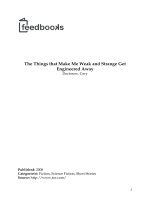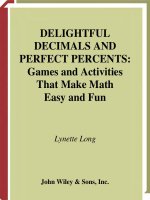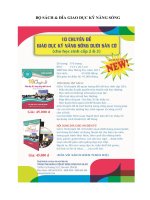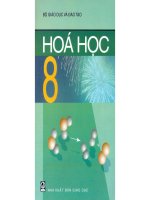Bộ sách Creative activities that make math science fun for kids Cool paper folding
Bạn đang xem bản rút gọn của tài liệu. Xem và tải ngay bản đầy đủ của tài liệu tại đây (5.93 MB, 34 trang )
-TO LIBRAR
Y
HOW
CHECKERB
OA
RD
COOL ART WITH MATH & SCIENCE
PAPER FOLDING
CREATIVE ACTIVITIES THAT MAKE MATH & SCIENCE
FUN FOR KIDS!
ANDERS HANSON AND ELISSA MANN
C O O L A R T W IT H MAT H & SCIEN CE
PAPER FOLDING
CREAT IVE A C TIVITIE S T H A T M A K E M A T H
FUN FOR KIDS!
ANDERS HANSON
&
SC I E N C E
AND ELISSA MANN
V I S IT U S AT W W W. A B D O P U B LI S H I N G.CO M
Published by ABDO Publishing Company, a division of ABDO, P.O. Box 398166, Minneapolis,
Minnesota 55439. Copyright © 2014 by Abdo Consulting Group, Inc. International copyrights
reserved in all countries. No part of this book may be reproduced in any form without written
permission from the publisher. Checkerboard Library™ is a trademark and logo of ABDO Publishing
Company.
Printed in the United States of America, North Mankato, Minnesota
062013
092013
Design and Production: Anders Hanson, Mighty Media, Inc.
Series Editor: Liz Salzmann
Photo Credits: Anders Hanson, Shutterstock
LIBRARY OF CONGRESS CATALOGING-IN-PUBLICATION DATA
Hanson, Anders.
Cool paper folding : creative activities that make math & science fun for kids! / Anders Hanson and
Elissa Mann.
p. cm. -- (Cool art with math & science)
Includes bibliographical references and index.
ISBN 978-1-61783-823-1
1. Paper work--Juvenile literature. 2. Origami--Juvenile literature. 3. Handicraft--Juvenile
literature. I. Mann, Elissa, 1990- II. Title.
TT870. H3139 2014
736.98--dc23
2013001899
C O NT E NT S
4
6
7
8
10
14
18
C O O L P A PE R F O L D I N G
FUN WI T H FOL DS
THE B A S I C S
PA P ER T YP ES A N D FOL D I N G T I P S
REG U L A R PO L Y GO N S
THE ESSEN T I A L SHA P ES
P LA T O N I C S O L I D S
THE R EG UL A R P OLYHED R ON S
P ROJE C T
1
FOLDI N G A P L ATON I C SOL I D
P ROJE C T
2
MA K ING A N I N JA STA R
MODULES
BITS A N D P I EC ES P UT TOG ET HE R
20
24
29
30
31
31
32
PROJEC T
3
M A K I N G A MO D U L A R C U B E
PROJEC T
4
FO L DI N G A CO M P L E X S H A P E
M A TH A ND BEA UTY
I S TH E R E A CO N N E C TI O N ?
M A TH TERM S
GLOS S A RY
W EB S ITES
INDEX
PAPER FOLDING
FUN WITH
FOLDS
H
ow many different things can you make by folding paper? You might
be surprised. Many kids make paper airplanes and boats. But you can
also make things such as cubes, tetrahedrons, and ninja stars. Get ready to
go on a paper-folding adventure!
4
The Japanese have been folding paper for
hundreds of years. They call it origami.
Most origami projects look like animals.
5
Modern paper folding
artists create colorful art
using only folded paper.
THE B AS I CS
PAPER TYPES AND FOLDING TIPS
F
olding paper can be fun. It can also be challenging. With some practice,
you will be a paper folding pro.
ORIGAMI PAPER
FOLDING TIPS
Use origami paper for paperfolding projects. It is available
at craft stores. It is lighter than
regular paper. This makes it
easy to fold. Most origami
paper is 6 inches by 6 inches
(15.24 cm by 15.24 cm).
» Be as accurate as possible when
you make your folds! Make sure
to crease the folds.
» Be patient. It can take a few tries
to get it right.
» Read the directions and look
at the pictures carefully. If you
don’t understand something, ask
a friend or an adult for help.
6
R E GU L AR P O L Y GO N S
THE ESSENTIAL SHAPES
A
polygon is a shape. Its sides are straight lines. In a regular polygon, all the sides are
the same length. And all the corners have the same angle.
THE FIRST EIGHT REGULAR POLYGONS
TRIANGLE
(3 SIDES)
SQUARE
(4 SIDES)
PENTAGON
(5 SIDES)
HEXAGON
(6 SIDES)
HEPTAGON
(7 SIDES)
OCTAGON
(8 SIDES)
ENNEAGON
(9 SIDES)
DECAGON
(10 SIDES)
7
PLA T O N IC SO L I D S
THE REGULAR POLYHEDRONS
A
platonic solid is a threedimensional shape. It is
also called a polyhedron. Its
faces are regular polygons.
Each face is the same.
There are five platonic
solids. They are the
tetrahedron, the cube,
the octahedron, the
dodecahedron, and the
icosahedron.
Make each solid by folding a
sheet of paper. The pattern
for each solid is shown on the
right. The dotted lines are
tabs for gluing or taping.
TETRAHEDRON
CUBE
MADE FROM
4 TRIANGLES
MADE FROM
6 SQUARES
8
OCTAHEDRON
MADE FROM
8 TRIANGLES
DODECAHEDRON
MADE FROM
12 PENTAGONS
9
ICOSAHEDRON
MADE FROM
20 TRIANGLES
ICOSAHEDRON
OCTAHEDRON
TETRAHEDRON
10
PROJ E C T
1
FOLDING
A PLATONIC
SOLID
STUFF
Y O U´L L
NEED
đƫ CARD STOCK
đƫ COLORED PAPER
đƫ RULER
đƫ PEN OR PENCIL
đƫ TAPE
đƫ SCISSORS
TERMS
đƫ TETRAHEDRON
đƫ FACE
đƫ EQUILATERAL
TRIANGLE
đƫ MIDPOINT
T
he tetrahedron is the simplest platonic solid. It has
four faces. Each face is an equilateral triangle.
The steps show how to fold a piece of paper into a
tetrahedron. Make the other platonic solids using the
same method. See pages 8–9 for the folding patterns.
11
1
HOW TO MAKE IT
1
Use a ruler to draw a 3-inch
(7.6 cm) line on card stock. This
is the base of the triangle.
2
Measure 1.5 inches (3.8 cm) in
from one end of the line. This is
the midpoint. Use the corner of a
piece of paper to draw a line up
from the midpoint. It should be
at least 3 inches (7.6 cm) long.
2
3 Draw a 3-inch (7.6 cm) line from each
end of the base line to the midpoint
line. This will form a triangle.
4 Cut out the triangle. You
will use it as a template.
5 Trace the template on a
piece of colored paper.
4
12
6
6
Trace three more triangles using the
template. Each triangle should share
a side with the first triangle. All the
triangles will form one big triangle.
7 Cut out the big triangle.
8
Fold each outer triangle in.
Crease them along the lines they
share with the center triangle.
8
9 Lift up two triangles. Tape
their edges together.
10 Put tape on the other edge of both
triangles. Press the edges of the
third triangle to the tape. This
completes the solid tetrahedron.
10
13
14
PROJ E C T
2
MAKING A
NINJA STAR
H
ave you ever seen ninjas in a movie? Ninjas carry
tiny metal stars in their pockets. They throw the
stars at their targets. You can make your own ninja
star, too! Try making this paper version.
Tip: It’s important to make firm creases. Make sure
you fold as accurately as possible!
15
STUFF
Y O U´L L
NEED
đƫ 2 PIECES
OF ORIGAMI
PAPER
TERMS
đƫ TRIANGLE
đƫ VERTICAL
2
HOW TO MAKE IT
1 Lay the paper facedown. Fold it in
half. Make a firm crease. Unfold it.
3
2
Fold one side of the paper to
the center crease. Crease it.
Repeat with the other side.
3
Leave the sides folded in. Fold
the paper on the center crease.
4 Repeat steps 1 through 3 with
a second piece of paper.
5 Lay them down with the folds
on the left. Fold the top right
corner of the first paper down.
Line up the corner with the left
edge. Fold the top left corner of
the second paper down. Line up
the corner with the right edge.
6
6
16
Fold the bottom left corner of the first
paper up. Line up the corner with
the right edge. Fold the bottom right
corner of the second paper up. Line
up the corner with the left edge.
7
On the first paper, fold the left edge
of the top half to the center. The top
point should be on the right side.
Fold the right edge of the bottom
half to the center. The bottom point
should be on the left side. The folds
will make two triangles with pockets.
Fold the top and bottom of the
second paper the opposite way.
8
Flip the first paper over. Turn it
so it’s vertical. Place the second
paper on top. Do not flip it over.
9
7
8
Fold the bottom right corner up.
Tuck it into the left triangle pocket.
Fold the top left corner down. Tuck
it into right triangle pocket.
10 Flip the papers over. Tuck in the
other corners the same way.
9
17
MO D U L E S
BITS AND PIECES PUT TOGETHER
M
odules are pieces that fit together.
They can be mixed and matched to
make something larger. Modules can always
be separated and put back together in a
different way. They are like building blocks!
Some origami projects are made with folded
modules. It is called modular origami. The
projects on pages 20 and 24 use modules.
REAL LIFE MODULES
A brick is an example of a real-life module.
Bricks are mostly the same size and shape.
When you put them together, they can make
a lot of things. Bricks can make a house, a
road, or an arch!
18
The Colosseum is an ancient stadium in Rome. It was built with bricks. In the 1300s an
earthquake destroyed part of it. Many bricks broke off. They didn’t go to waste, though.
Because bricks are modular, they were reused in other buildings!
19
20
P ROJE C T
3
MAKING A
MODULAR CUBE
STUFF
Y O U´L L
NEED
đƫ 6 SHEETS
OF ORIGAMI
PAPER
TERMS
đƫ HORIZONTAL
đƫ CUBE
đƫ DIAGONAL
I
n modular origami, many identical pieces are put
together. They make a new shape.
In this project, you will make six identical modules.
Then you’ll join them together to make a cube!
21
2
HOW TO MAKE IT
1 Fold a piece of paper in half.
Make a firm crease. Unfold it.
3
2
Fold one side of the paper
to the center crease. Crease
it. Repeat with the other
side. Flip the paper over.
3
Fold the right top corner down.
Line it up with the left edge.
Fold the left bottom corner up.
Line it up with the right edge.
4 Fold the bottom corner up. Line
it up along the left edge. Fold
the top corner down. Line it up
along the right edge. Crease the
folds. Open up the last two folds.
4
5 Repeat steps 1 though 4 with the
other sheets of paper. Flip them
all over. They should each have
a diagonal slot in the middle.
22
6
6
Lay one folded paper horizontally.
Slide one point of the second paper
into the first paper’s slot from the
top. Slide one point of the third paper
into the slot from the bottom.
7 Flip the three connected papers
over. Fold up the second and third
papers. They should stick up on
either side of the first paper.
8
Hold the fourth paper between
the raised ends of the second and
third papers. Fold the point of the
second paper over the fourth paper
and into its slot. Do the same with
the point of the third paper.
9
Add the last two papers to the sides the
same way. Fold the points over and tuck
them into the slots from the outside.
8
9
23









